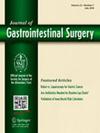Is stapled Kono-S anastomosis a protective factor against postoperative endoscopic recurrence in Crohn disease? A single-center, retrospective cohort study
IF 2.2
3区 医学
Q3 GASTROENTEROLOGY & HEPATOLOGY
引用次数: 0
Abstract
Background
Handsewn Kono-S anastomosis is safe and associated with a reduction in postoperative recurrence (POR) in Crohn disease (CD). This study aimed to investigate the advantages of stapled Kono-S anastomosis in patients with CD who underwent intestinal anastomosis.
Methods
Patients with CD who underwent intestinal anastomosis were reviewed via a prospectively maintained database. Patients who underwent conventional stapled side-to-side anastomosis were classified into the conventional group, and those who underwent stapled Kono-S anastomosis were classified into the Kono-S group. The primary endpoint was modified endoscopic recurrence (mER; ≥i2b). Other endpoints were endoscopic recurrence (ER; ≥i2); severe ER (i3 and i4); intra- and postoperative outcomes, including morbidity and hospital stay; and cross-sectional parameters. Multivariate logistic regression analysis was performed to assess the independent risk factors for mER.
Results
Between 2020 and 2023, 199 patients (63 in the Kono-S group) were included in this study. After matching the 63 patients in each group, the overall rates of mER, ER, and severe ER were 19.0%, 24.6%, and 8.7%, respectively. The mER, ER, and severe ER rates were lower in the Kono-S group than in the conventional group (12.7% vs 25.4% [P =.07], 20.6% vs 28.6% [P =.30], and 6.3% vs 11.1% [P =.34], respectively). Multivariate analysis indicated that stapled Kono-S anastomosis (odds ratio [OR], 0.35; 95% CI, 0.12–0.98; P =.047) was an independent protective factor for mER, whereas male gender (OR, 7.75; 95% CI, 1.50–40.00; P =.01) and BMI of <18.5 kg/m2 (OR, 3.27; 95% CI, 1.11–9.67; P =.03) were independent risk factors for mER.
Conclusion
Stapled Kono-S anastomosis is safe for patients with CD. However, stapled Kono-S anastomosis may not be a protective factor against POR compared with conventional stapled side-to-side anastomosis.
吻合器Kono-S吻合术是防止克罗恩病术后内镜下复发的保护因素吗?单中心回顾性队列研究。
背景:手工缝合的Kono-S吻合是安全的,并且与克罗恩病(CD)术后复发(POR)的减少有关。本研究旨在探讨吻合器Kono-S在克罗恩病患者肠吻合术中的优势。方法:通过前瞻性维护的数据库对行肠吻合术的克罗恩病患者进行回顾性分析。采用常规侧侧吻合术的患者为常规组,采用Kono-S吻合术的患者为Kono-S组。主要终点是改良内镜下复发(mER,≥i2b)。其他终点包括ER(≥i2)、严重ER (i3和i4)、术中和术后结局(包括发病率和住院时间)以及横断面参数。采用多变量logistic分析评估mER的独立风险。结果:2020 - 2023年共纳入199例患者,其中Kono-S组63例。匹配后,每组63例患者,轻度急性发作、ER急性发作和重度ER急性发作的总发生率分别为19.0%、24.6%和8.7%。Kono-S组mER、ER及重度ER发生率均低于常规组(12.7% vs. 25.4%, p=0.07;20.6% vs. 28.6%, p=0.30;6.3% vs. 11.1%, p=0.34)。多因素分析表明,装订的Kono-S (OR=0.35;95% CI: 0.12-0.98, p=0.047)是mER的独立保护因素,而男性(OR=7.75;95% CI: 1.5-40.0, p=0.01)和bmic结论:与传统的侧对侧吻合术相比,吻合式Kono-S吻合术对CD是安全的,但可能不是预防POR的保护因素。
本文章由计算机程序翻译,如有差异,请以英文原文为准。
求助全文
约1分钟内获得全文
求助全文
来源期刊
CiteScore
5.50
自引率
3.10%
发文量
319
审稿时长
2 months
期刊介绍:
The Journal of Gastrointestinal Surgery is a scholarly, peer-reviewed journal that updates the surgeon on the latest developments in gastrointestinal surgery. The journal includes original articles on surgery of the digestive tract; gastrointestinal images; "How I Do It" articles, subject reviews, book reports, editorial columns, the SSAT Presidential Address, articles by a guest orator, symposia, letters, results of conferences and more. This is the official publication of the Society for Surgery of the Alimentary Tract. The journal functions as an outstanding forum for continuing education in surgery and diseases of the gastrointestinal tract.

 求助内容:
求助内容: 应助结果提醒方式:
应助结果提醒方式:


